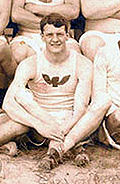Robert Cloughen
| athletics | ||
| silver | 1908 | 200 m |
Robert "Bobby" T. Cloughen (* 26. January 1889 in New York ( New York ), United States ; † 12. July 1930 in Mountain Lakes ( New Jersey ), United States) was an American athlete and a sprinter , a Medalist at the 1908 London Olympics .
Life
Robert Cloughen was held the son of Louisa H. Cloughen and the influential entrepreneur John Cloughen, the way public in New York City offices and briefly Borough President in New York's Manhattan was what the post of Bezirksvorstehers or district mayor was similar.
Cloughen attended one of Fordham University affiliated colleges , but without successfully completing a final exam. For that he had more success on the university football team . Mainly used as a ball carrier, he caused a stir with his speed. He moved to Morris High School and became a member of the Irish American Athletic Club , a highly respected sports club at the time, in which many top athletes had come together.
In 1907 Cloughen took part in the national athletics championships of the Amateur Athletic Union (AAU) with his club . Cloughen did not win a title, but contributed to his team's overall victory and was henceforth a respected athlete. For the Olympic Games to be held in London in 1908 , the club had selected a number of athletes, including Robert Cloughen.
In London, Cloughen's first competition was the number 5 of 17 in the 100-meter run . Only the winners qualified for the intermediate runs on the following day. Cloughen easily won his run by over four meters. On the day of the intermediate runs over 100 meters, the preliminary runs for the 200-meter run also took place beforehand . Here, too, only the winners of 15 runs qualified for the intermediate runs. Cloughen had only one opponent in his forerun, whom he defeated by over 5 meters. The reasons why he did not start the 100 meter intermediate run are unknown.
In the third of four intermediate runs over 200 meters, of which only the winners made it to the finals, Cloughen did not have it so easy. He won the run by just under a meter.
In the final, Cloughen was a blatant outsider, as his opponents had various championship titles and Olympic experience. Unimpressed by this, Cloughen delivered a strong run. With a jump to the finish, he missed victory by just inches.
In 1908 Cloughen finally won his first title at the national championships of the AAU. He won the juniors run over 100 yards and also started the seniors over 220 yards, where he finished third. In December 1908, he took part in the national indoor championships and won over 60 yards, equalizing the American record with 6.4 s, and over 75 yards. In the weeks and months that followed, Cloughen ran more records of 70 and 130 yards. The time of 12.8 s over 130 yards (118.9 m) was the fastest time ever achieved over this distance worldwide. This made Cloughen the best American sprinter in the following years.
In 1909, as a member of his club's relay team, Cloughen helped set a new record for the five- mile relay race .
In 1910 Cloughen was again a two-time indoor champion over 60 and 75 yards. In addition, he set another record in a run over 110 yards, which was not a championship course, because nobody in the world had run 10.8 s for 110 yards (100.6 m) before. That same year he was also elected to the All America Athletic Team , representing the best US athletes of the year in their respective disciplines. Cloughen received the award for best runner over 75 yards.
Cloughen now attended New York University and the Savage School of Physical Education in New York. Since 1911 it has been quiet about his sporting career, the reasons are in the dark. It was not until 1922 that Cloughen reappeared in the public eye, when he was appointed chief instructor for athletics at the University of Vermont . In 1926 he switched to the Erasmus Hall Academy as a trainer .
Cloughen died unexpectedly and suddenly while training in 1930. It is claimed that he was preparing to make a comeback for the Olympics. The date of death 7 August given in previous publications is incorrect and is refuted by the grave of Robert Cloughen in Green-Wood Cemetery in New York.
Placements at the Olympic Games
- 1908 Olympic Games, London
- 200 m - SILVER with 22.6 s (gold to Robert Kerr , Canada , with 22.6 s; bronze to Nathaniel Cartmell , United States , with 22.7 s)
- 100 m - preliminary winner with 11.0 s, not started in the intermediate run
Note: With the exception of the time of the winner, the running times are estimated as there was no time measurement for those placed. With them, the gap to the winner or the first place was determined with a length specification.
Web links
- Robert Cloughen in the Sports-Reference database (English; archived from the original )
- Robert Cloughen at findagrave.com (English)
- wingedfist.com homepage for the Irish American Athletic Club (English)
| personal data | |
|---|---|
| SURNAME | Cloughen, Robert |
| ALTERNATIVE NAMES | Cloughen, Robert T .; Cloughen, Bobby (nickname) |
| BRIEF DESCRIPTION | American athlete |
| DATE OF BIRTH | January 26, 1889 |
| PLACE OF BIRTH | new York |
| DATE OF DEATH | July 12, 1930 |
| Place of death | Mountain Lakes |
